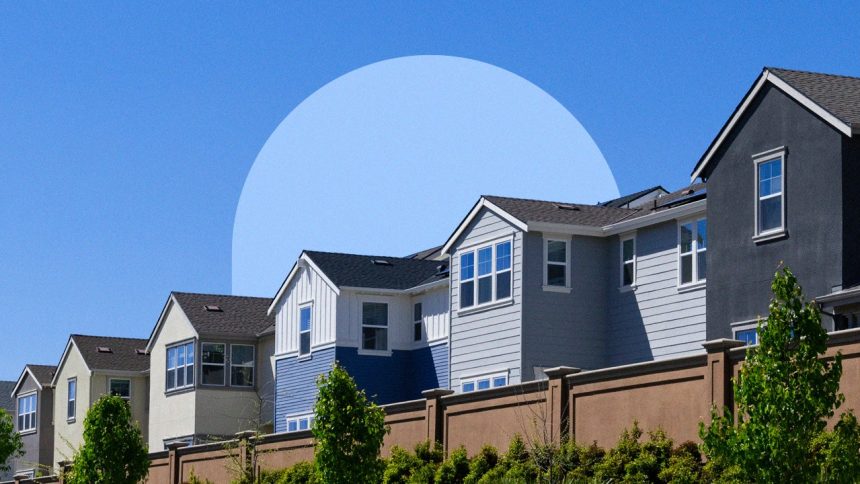Key takeaways
- In the past 60 years, home prices have grown more than twice as fast as wages.
- In addition, mortgage payments have doubled in the past decade.
- Taxes and homeowners insurance premiums are also up significantly, putting the squeeze on both homeowners and would-be buyers.
Has it ever been harder to buy a home?
If you’ve been house shopping recently — or just following the news — you know the housing market is tough. Low inventory, combined with rising prices, mortgage rates, homeowners insurance and other costs, can make homebuyers feel like they’re running the gauntlet.
To understand how we got here, it’s helpful to understand what housing affordability is, where it’s been and where it’s headed.
What we mean when we say ‘housing affordability’
One of the most common standards used when measuring housing affordability is the 28/36 rule. This guideline states that you should spend no more than 28 percent of your income on housing costs, and no more than 36 percent of your income on all debt payments, including housing. Unfortunately, today’s prices and mortgage rates make this rule too limiting for many would-be homebuyers, who might have to stretch their budget far beyond 28 percent to afford a house.
“I think of housing affordability as encompassing the broad spectrum of hurdles consumers must clear in order to purchase their home, such as debt-to-income ratio, credit, down payment and job stability,” says Brad Seibel, president of Sage Home Loans. (Sage, like Bankrate, is part of Red Ventures.)
Seibel explains that affordability is a combination of larger economic forces and your personal finances. “As an example, a low interest rate helps the consumer’s ability to meet debt-to-income ratios,” he says. “But at the same time, rising prices driven by those low interest rates increase the consumer’s down payment requirements due to higher home purchase prices.”
It’s a balance you may have noticed at play in recent years. Historically low interest rates led to increased homebuying demand, which, paired with years of low inventory, drove up home prices. This rise in home prices greatly contributed to heightened inflation — and the Federal Reserve then raising interest rates to fight it off.
Now, the housing market has both higher prices and higher rates, which for many is reshaping the American Dream.
The government’s history in affordable homebuying
The way we buy and sell homes in the U.S. has changed dramatically over the last century. In fact, today’s most popular tool for home financing, the 30-year mortgage, wasn’t even approved by Congress until 1948 for new construction homes and even later — 1954 — for existing homes. Without these long-term mortgage loans, far fewer people would have access to homeownership.
Here are a few other key pieces of legislation aimed at more affordable and equitable homeownership in the U.S.:
- National Housing Act of 1934 and Housing Act of 1937: Created the Federal Housing Administration in the wake of bank foreclosures during the Great Depression. These laws did a lot to stabilize mortgages and housing — however, they also led to more institutionalized racial discrimination in housing, in part due to policies like redlining.
- Department of Housing and Urban Development (HUD) Act of 1965: Established HUD as an executive agency focused on implementing housing policy across the country’s metropolitan areas.
- Fair Housing Act: Part of the larger Civil Rights Act of 1968, expanding on previous legislation to outlaw discrimination based on characteristics including race, sex and religion in the sale, rental and financing of housing.
Since these laws were enacted, the government has taken a multitude of varied steps to create affordable housing assistance. For instance, many state and local first-time homebuyer programs receive federal funding.
Home prices have severely outpaced income
When compared to the rise in home prices, wage growth in the U.S. has not come anywhere close to keeping up.
From 1964 to 2022, home prices grew more than twice as fast as wages, according to U.S. Census data.
In 1964, the median household income was $6,569, according to the U.S. Census Bureau. That same year, the typical home price was $18,925. That means the median income made up about a third of the typical home price.
Fast forward to 2022 (the most recent year for Census income data): The median household income was up to $74,580 — more than 10 times what it was in 1964. That sounds like high growth, but not when you look at home prices: That same year, the typical home price was $432,950 — more than 20 times higher than the typical home price in 1964. The median income made up around 34 percent of the home price in 1964, but by 2022, that had shrunk to just 17 percent.
Home prices + interest rates = Paying twice as much for a home
Rising home prices are just part of the declining affordability puzzle. The next piece: interest rates.
As recently as 10 years ago, mortgage interest rates were much lower than they are now. The average rate on a 30-year fixed mortgage in 2014 was 4.3 percent, according to Bankrate’s survey of the nation’s largest lenders. Between 2014 and 2021, average mortgage rates fluctuated between 3.15 and 4.7 percent.
Rates then shot up in 2022 and 2023, due in large part to the Fed raising its key rate to combat inflation, with the average for 2023 being 7 percent even.
When you combine the increase in home prices with the rise in interest rates using Bankrate’s mortgage calculator, principal and interest mortgage payments more than doubled between 2014 and 2023 — from $1,131 to $2,270, with 66 percent of that increase happening between 2021 and 2023.
Home affordability by metro area over the past 10 years
To illustrate how home affordability has changed in different places over the past 10 years, we looked at 25 metropolitan areas based on population and geographic location. This breakdown uses the National Association of Home Builders/Wells Fargo Housing Opportunity Index (now called the Cost of Housing Index), which is based on the percentage of homes sold in the area that would have been affordable to a family earning the local median income.
All 25 of these metros saw double-digit decreases in home affordability in the past 10 years. The five areas that saw the greatest decrease in affordability are:
- Los Angeles-Long Beach-Glendale, California: Only 18.38 percent of homes were affordable on a median income in 2014, but that shrunk to just 3.18 percent in 2023 — an 82.7 percent decrease.
- Miami-Miami Beach-Kendall, Florida: Nearly 50 percent of homes were affordable on a median income in 2014. In 2023, that was down to 13.08 percent — a 73.73 percent decrease.
- Riverside-San Bernardino-Ontario, California: Went from 48 percent of homes being affordable in 2014 to 13.43 percent in 2023 — a 72.02 percent decrease.
- Boise City, Idaho: Close to 63 percent of homes sold were affordable on a median income in 2014 in Boise. In 2023, that dropped by 62.8 percent to just 18.23 percent of homes being affordable.
- Portland-Vancouver-Hillsboro, Oregon-Washington: In 2014, 56.85 percent of homes sold were affordable on a median income, but that fell to 22.23 percent of homes sold in 2023.
Of the metros that saw the smallest decrease in home affordability, three are in the Midwest (Chicago, Detroit and St. Louis) and two are on the East Coast (Philadelphia and Baltimore).
Are homes less affordable now than ever?
Along with buying a home, actually owning a home has gotten more expensive as well. For example:
- Property taxes: As home prices have increased, so has the amount of taxes collected on them. Property taxes increased 7 percent nationally in 2023 alone, according to data from ATTOM.
- Homeowners insurance: The average homeowners insurance premium for a policy with $300,000 in dwelling coverage rose by 7 percent from January 2022 to January 2024 according to Bankrate data.
- Maintenance costs: The average costs of homeownership in the U.S. have increased by 26 percent from 2020 to 2024, according to a June Bankrate survey about the costs of homeownership.
Buying a home isn’t just more difficult than it was three or four years ago — it’s more difficult than it’s been in a very long time. “Now is one of the most difficult environments in my 30-plus years of finance to purchase a home,” Seibel says. “High interest rates coupled with low inventory and higher home prices after significant appreciation is squeezing the consumer from all sides.”
Homes don’t seem poised to become much more affordable in the short term, either. From 1976 through 2023, homes appreciated at an average of 5 percent per year, according to the Federal Housing Finance Agency’s House Price Index. However, during 2021 and 2022, home prices grew by nearly 12 percent and 16 percent respectively. This was due largely to low rates and low inventory.
Home sale prices are still on the rise in much of the country, but the rate is closer to the average rate of appreciation: The median national sale price in May 2024 was up just over 5 percent since last year, according to Redfin data.
Along with rising prices, the Federal Reserve seems determined to keep interest rates elevated until inflation settles to its 2 percent target. High rates and high prices are keeping the pressure on homebuyers.
What does the future look like for home affordability?
With high mortgage rates and slowing sales, it’s possible that price growth could slow, offering relief to homebuyers. And if inflation slows enough, the Fed will likely cut interest rates, which could help both buyers and sellers.
“I do think home affordability will improve in the near future,” Seibel says. “It’s a function of the expected drop in interest rates and the recent flattening of the price appreciation in some markets.”
But the crystal ball is cloudy. Home prices have yet to come down much, and rate cuts could be further off than expected — in its June meeting, the central bank said they expect only one rate cut this year. Also, if mortgage rates drop enough, those who might be waiting for lower rates to buy could jump back into the market. That increased demand could drive up home prices further.
“The wildcard is [whether] lower rates trigger a resurgence in value appreciation,” Seibel says. “If that’s the case, we will just be chasing our tail for an improvement in affordability.”
Read the full article here














